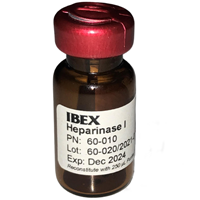Heparinase High Purity Enzymes for Glycobiology Research

IBEX has developed a proprietary expression system for the production of our enzymes in Flavobacterium heparinum. This system allows for the production of each glycosaminoglycan enzyme in a way that minimizes the cross contamination of other GAG enzymes which can occur when enzymes are produced from the native strain of Flavobacterium heparinum (Pedobacter heparinus). When combined with our well-defined proprietary purification process our enzymes are of the highest purity. We produce 3 heparinase types, a brief description of the heparinase enzymatic function appears below. Further details can be found on our Heparinase website
Due to its high purity and reaction time IBEX Heparinase I is the only heparinase used in FDA and EU approved hemostasis-measuring Point Of Care devices.

| Product | Substrate | Purity* |
| Heparinase I | Heparin & Heparan Sulfate | ≥ 95% |
| Heparinase II | Heparan Sulfate & Heparin | ≥ 90% |
| Heparinase III | Heparan sulfate | ≥ 95% |
| * By reversed phase HPLC analysis | ||
| The IBEX Quality Management System is Certified ISO 13485 for the Manufacturing of Enzymes sold as reagents or incorporated in diagnostic devices. |
Please note that the IBEX definition of units differs from the Sigma definition.
IBEX enzymes are sold in “International Units”. For heparinase this means that one international unit (IU) is defined as the amount of enzyme that will liberate 1.0 µmole unsaturated oligosaccharides from heparin or heparan sulfate per minute (at 30 °C and pH 7.5).
Sigma Units are defined as follows:
One unit (Sigma unit) will form 0.1 μmole of unsaturated uronic acid per hour at pH 7.5 at 25 °C.
Therefore one IBEX unit (IU) is equivalent to approx. 600 Sigma units.
Heparinase I
Synonyms: Heparinase; heparin lyase; heparin eliminase
Source: Flavobacterium heparinum (recombinant)
Catalyzed Reaction: The enzyme cleaves selectively, via an elimination mechanism, highly sulfated
polysaccharide chains containing 1-4 linkages between hexosamines and Osulfated iduronic acid residues. The reaction yields oligosaccharide products
(mainly disaccharides) containing unsaturated uronic acids which can be
detected by UV spectroscopy at 232 nm. The enzyme also cleaves the
antithrombin III binding pentasaccharide domain in the heparin molecule.
Substrate Specificity: Heparin; heparan sulfate (specific activity with heparin is approx. 3 times higher
than with heparan sulfate).
Heparinase II
Synonyms: Heparitinase
Source: Flavobacterium heparinum (recombinant)
Catalyzed Reaction: The enzyme cleaves, via an elimination mechanism, sulfated polysaccharide
chains containing 1-4 linkages between hexosamines and uronic acid residues
(both iduronic and glucuronic acid residues). The reaction yields oligosaccharide
products (mainly disaccharides) containing unsaturated uronic acids which can
be detected by UV spectroscopy at 232 nm. The enzyme cleaves both heparin
and heparan sulfate, with the heparan sulfate activity being about twice as high
as the heparin activity.
Substrate Specificity: Heparin, heparan sulfate.
Heparinase III
Synonyms: Heparitinase
Source: Flavobacterium heparinum (recombinant)
Catalyzed Reaction: The enzyme cleaves, via an elimination mechanism, sulfated polysaccharide chains containing 1-4 linkages between hexosamines and uronic acid residues (both iduronic and glucuronic acid residues). The reaction yields oligosaccharide products (mainly disaccharides) containing unsaturated uronic acids which can be detected by UV spectroscopy at 232 nm. The enzyme cleaves both heparin and heparan sulfate, with the heparan sulfate activity being about twice as high as the heparin activity.
Substrate Specificity: Heparin, heparan sulfate.
IBEX produces high purity enzyme products that do not contain preservative agents or proteinaceous stabilizers such as albumins.
Our enzymes are sold in either lyophilized or frozen liquid form. Enzymes formulated as liquids are shipped on dry ice. Each shipment is accompanied by a certificate of analysis.
IBEX sells its enzymes in International Units (IU). One international unit is defined as “the amount of enzyme that will liberate 1.0 µmole per minute of unsaturated oligosaccharides from substrates at 30°C and pH 7.0 (Heparinase I), 7.5 (Heparinase II and III)”.
IBEX Pharmaceuticals’ heparinases are now available in Freeze-Dried Powder form!



